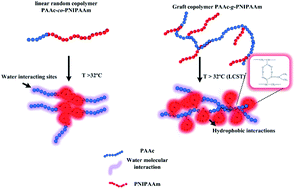A thermally triggered in situ hydrogel from poly(acrylic acid-co-N-isopropylacrylamide) for controlled release of anti-glaucoma drugs†
Abstract
The purpose of this study was to develop and evaluate thermally responsive copolymers, which contain temperature- and pH-sensitive segments that are either alternating in or grafted onto the main chain, and to exploit their temperature-sensitive properties for ophthalmic drug delivery. Accordingly, two types of thermoresponsive copolymers—a linear poly(acrylic acid-co-N-isopropylacrylamide) random copolymer (PAAc-co-PNIPAAm) and a poly(acrylic acid-g-N-isopropylacrylamide) graft copolymer (PAAc-g-PNIPAAm)—were investigated for their thermosensitive in situ gel formation and potential applications for ophthalmic drug delivery. All the PAAc-g-PNIPAAm graft copolymers, and the linear PAAc-co-PNIPAAm copolymer with low acrylic acid contents, have an LCST of 34 °C; this is close to the surface temperature of the eye and can therefore be utilized for ophthalmic drug delivery. In addition, the PAAc-g-PNIPAAm graft copolymers showed a higher water content than the linear random copolymer; this is due to the high water adsorption ability of PAAc. The drug release dynamics of [3H]-epinephrine as a model showed that the linear random copolymer has a faster drug release, while the graft copolymers showed a more sustained release profile. The Ritger–Peppas model was used to account for the release of the epinephrine diffusion exponent ‘n’ which was in between 0.5 and 0.6. The release of the drug is considered mainly dependent on diffusion but other factors cannot be excluded. We suspected that the dynamics of drug release are determined by the water adsorption ability because high water content results in the formation of a larger capillary network in the polymer matrix, which promotes drug diffusion into the copolymer. The results suggest that PAAc-g-PNIPAAm graft copolymers are potential thermosensitive in situ gel-forming materials for ophthalmic drug delivery.


 Please wait while we load your content...
Please wait while we load your content...